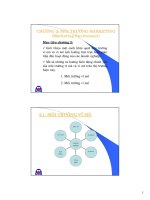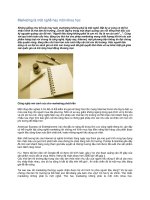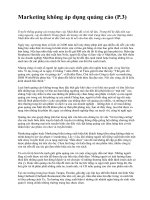Tài liệu Marketing - E-Book - Mcgraw Hill - Power Sales Writing Ebook pptx
Bạn đang xem bản rút gọn của tài liệu. Xem và tải ngay bản đầy đủ của tài liệu tại đây (811.74 KB, 193 trang )
PRAISE FOR
POWER SALES WRITING
“A valuable tool to enhance our writing and sales effectiveness skills.
This book should be in every school and business.”
—Howard Putnam, author of The Winds of Turbulence
and former CEO of Southwest Airlines
“Sue Hershkowitz-Coore’s latest book, Power Sales Writing, is a
basic, down-to-earth, easy read that will help anyone improve their
writing and communication skills. Sue’s delightful personality is
evident in this valuable reference tool.”
—John H. Schnatter, CEO, Papa John’s Pizza
“I’ve been training sales professionals for more than twenty years,
and this is the best book I’ve ever read on effective sales writing.”
—Brian Tracy, bestselling author, Goals!
“Business success is becoming more dependent on the ability to
differentiate and sell your company (and yourself) through your
writing skills. The hands-on messages in Power Sales Writing are crit-
ical to winning in today’s fast-paced global economy.”
—Roger Dow, Senior Vice President, Global and Field Sales,
Marriott International, Inc.
“This book will teach you to write better and faster.”
—Fred Shea, Vice President-Sales Operations,
Hyatt Hotels Corporation
This page intentionally left blank.
POWER
SALES WRITING
This page intentionally left blank.
POWER
SALES WRITING
Sue Hershkowitz-Coore
McGraw-Hill
New York Chicago San Francisco Lisbon London
Madrid Mexico City Milan New Delhi San Juan
Seoul Singapore Sydney Toronto
Copyright © 2004 by Sue Hershkowitz-Coore. All rights reserved. Manufactured in the United States of
America. Except as permitted under the United States Copyright Act of 1976, no part of this publication
may be reproduced or distributed in any form or by any means, or stored in a database or retrieval
system, without the prior written permission of the publisher.
0-07-143588-3
The material in this eBook also appears in the print version of this title: 0-07-141033-3.
All trademarks are trademarks of their respective owners. Rather than put a trademark symbol after
every occurrence of a trademarked name, we use names in an editorial fashion only, and to the benefit
of the trademark owner, with no intention of infringement of the trademark. Where such designations
appear in this book, they have been printed with initial caps.
McGraw-Hill eBooks are available at special quantity discounts to use as premiums and sales pro-
motions, or for use in corporate training programs. For more information, please contact George
Hoare, Special Sales, at or (212) 904-4069.
TERMS OF USE
This is a copyrighted work and The McGraw-Hill Companies, Inc. (“McGraw-Hill”) and its licensors
reserve all rights in and to the work. Use of this work is subject to these terms. Except as permitted
under the Copyright Act of 1976 and the right to store and retrieve one copy of the work, you may not
decompile, disassemble, reverse engineer, reproduce, modify, create derivative works based upon,
transmit, distribute, disseminate, sell, publish or sublicense the work or any part of it without
McGraw-Hill’s prior consent. You may use the work for your own noncommercial and personal use;
any other use of the work is strictly prohibited. Your right to use the work may be terminated if you
fail to comply with these terms.
THE WORK IS PROVIDED “AS IS”. McGRAW-HILL AND ITS LICENSORS MAKE NO GUAR-
ANTEES OR WARRANTIES AS TO THE ACCURACY, ADEQUACY OR COMPLETENESS OF
OR RESULTS TO BE OBTAINED FROM USING THE WORK, INCLUDING ANY INFORMA-
TION THAT CAN BE ACCESSED THROUGH THE WORK VIA HYPERLINK OR OTHERWISE,
AND EXPRESSLY DISCLAIM ANY WARRANTY, EXPRESS OR IMPLIED, INCLUDING BUT
NOT LIMITED TO IMPLIED WARRANTIES OF MERCHANTABILITY OR FITNESS FOR A
PARTICULAR PURPOSE. McGraw-Hill and its licensors do not warrant or guarantee that the func-
tions contained in the work will meet your requirements or that its operation will be uninterrupted or
error free. Neither McGraw-Hill nor its licensors shall be liable to you or anyone else for any inac-
curacy, error or omission, regardless of cause, in the work or for any damages resulting therefrom.
McGraw-Hill has no responsibility for the content of any information accessed through the work.
Under no circumstances shall McGraw-Hill and/or its licensors be liable for any indirect, incidental,
special, punitive, consequential or similar damages that result from the use of or inability to use the
work, even if any of them has been advised of the possibility of such damages. This limitation of lia-
bility shall apply to any claim or cause whatsoever whether such claim or cause arises in contract, tort
or otherwise.
DOI: 10.1036/0071435883
ebook_copyright 6x9.qxd 10/24/03 12:00 PM Page 1
In loving memory of my daddy,
Philip Hershkowitz,
who would have liked this idea.
This page intentionally left blank.
Contents
Acknowledgments xi
Introduction xiii
PART ONE
GETTING STARTED 1
Chapter 1: Getting Started 3
Chapter 2: Putting the Prewriting Questions
to Work 9
Chapter 3: Writing Made Easy! 19
Chapter 4: Revision: Your Final Step 27
PART TWO
THE PSYCHOLOGY OF WRITING 37
Chapter 5: Writing Routine Messages 39
Chapter 6: Plan B: Writing to Hostile Readers 47
Chapter 7: The Buffer Zone 53
Chapter 8: Delivering the Bad News Positively,
Persuasively, and Professionally 61
ix
For more information about this title, click here.
Copyright 2004 by Sue Hershkowitz-Coore. Click Here for Terms of Use.
Chapter 9: End Friendly and Cooperatively 67
Chapter 10: Never Say You’re Sorry 73
PART THREE
SELLING YOUR IDEAS 81
Chapter 11: Focus on What Matters to Them 83
Chapter 12: Grab Their Attention to Sell Your Idea 93
Chapter 13: Build Interest to Keep Them with You 101
Chapter 14: Deliver Your Features 107
Chapter 15: Educate Enough, but Not Too Much 113
Chapter 16: Ask for What You Want 123
PART FOUR
PUTTING IT ALL TOGETHER 133
Chapter 17: The Conversational Test 135
Chapter 18: Choose the Correct Word 147
Chapter 19: Email Etiquette 159
Chapter 20: Enhance Your Worth 167
Index 171
x
Contents
Acknowledgments
This book would not have been written had it not been for the
thousands and thousands of Power Writing workshop attendees
who wanted to learn more, know more, practice more. They prod-
ded me to create a book that they could take home to review so
that they could remember the powerful new ideas they had heard,
and that would provide more detail and depth than could be pre-
sented during a corporate training session. I am grateful to them
for asking.
I am thankful for my friends in the National Speakers Associ-
ation who encouraged me to write my book. Without my best
NSA buddy, Joe Charbonneau, I wouldn’t have had a career, let
alone a book. Larry Winget must also be mentioned for his
unique way of motivating me to write.
Barry Neville at McGraw Hill approached me with the idea of
updating the book. I am grateful to him, and for his offer to help
me with “writer’s block.” It was procrastination, Barry! Thank you
for understanding my schedule, and for having a sense of humor
through the whole thing. To Janice Race, and all the unseen edi-
tors I know only through your initialed comments, thank you for
not allowing me to embarrass myself with my own words! Thank
you for your graciousness, patience, and professionalism.
xi
Copyright 2004 by Sue Hershkowitz-Coore. Click Here for Terms of Use.
Thank you, also, to my mother, Lois Hershkowitz, for under-
standing my crazy, ever-busy work life. The same goes for my
friends. I appreciate that we are still friends, even if I didn’t sur-
face often!
To my son, Michael, thank you for being my best teacher. You
have always helped me to see what is really important in life.
And to my husband, Bill, thank you for everything. Always
and beyond.
xii
Acknowledgments
Introduction
As soon as you move one step up from the bottom, your effec-
tiveness depends on your ability to reach others through the
written or spoken word.
Peter Drucker
Power Sales Writing will help you communicate your ideas profes-
sionally and powerfully. You’ll receive the respect and recognition
you deserve and get the results you desire.
Whether you are a well-seasoned veteran or working toward
the Rookie of the Year award, this book is for you. Chock full of
writing strategies to help you build stronger relationships, en-
hance your credibility in the eyes of your customers and col-
leagues, and feel confident about your professionalism, this book
is specific, realistic, and even fun to read.
Power Sales Writing was written for the hard working, intelli-
gent, capable people, in all professions, who were misled in En-
glish class! Too many of us were taught wrong stuff by
well-meaning English teachers. Those teachers were good folks,
xiii
Copyright 2004 by Sue Hershkowitz-Coore. Click Here for Terms of Use.
but they never saw the inside of an office (or had to deal with of-
fice politics) and never had to write an email to persuade a pros-
pect to see them (and make quota) or to create a sales proposal to
close a deal (and get a commission). Too many of us learned if we
could write to please a specific teacher or professor, we’d be okay,
when in reality we had to learn much more than they could teach.
We had to learn not only technique and the psychology of writ-
ing, but also how to compel another busy professional to pay at-
tention and respond to our words.
Many people existed for years without the benefit (and bane!)
of email. Some of us were lucky enough to have others do our
writing for us. Today, regardless of title or position, we each must
respond to and create our own powerful, professional e-messages.
This book provides specific techniques and tools to show you how
you can write those e-messages thoughtfully and thoroughly to
lessen the worry of liability and to get your point across quickly
and clearly.
Power Sales Writing is practical, down-to-earth, and fun. It’s
loaded with fresh new ways to sell your ideas, your products, and
your services. You can (and should!) apply the easy-to use-ideas
immediately to dramatically increase the amount of money you
put in your pocket and drive revenue for your company.
If you have always wanted to feel confident and comfortable
with your writing skills, this book shows you exactly what to do.
Power Sales Writing is packed with ideas to help you:
• Save up to 80 percent of the time you now spend writing
• Entice your reader to read—and keep reading!
• Format your message for maximum impact
• Ask for—and get—action
xiv
Introduction
• Avoid embarrassing yourself with outdated, silly expressions
• Use your selling time more effectively and profitably
• Persuade others to see your point of view
• Write respectfully to build profitable relationships
• And much, much more!
Use just one idea from this book and you’ll write better.
Apply them all and the sky is the limit!
Introduction
xv
This page intentionally left blank.
PART
ONE
GETTING STARTED
Results. Respect. Recognition. That’s what this book is about—
writing in a manner that will get you what you want and give your
reader what he or she needs.
Use the techniques in this first section and you’ll create great
documents quickly. You’ll forget that high school English teacher
whom you could please only if you wrote exactly her way (and
you know she spent her entire life in academia, never having the
pressure you have to make a sales quota, differentiate a product,
or convince your manager to buy into your idea). Learn these
fundamental and powerful strategies and you’ll enjoy greater
confidence and save up to 80 percent of the time you now
spend writing.
You can write more quickly, more powerfully, and more confi-
dently. Start now!
Copyright 2004 by Sue Hershkowitz-Coore. Click Here for Terms of Use.
This page intentionally left blank.
1
Getting Started
Without a plan, it doesn’t matter which way you’re going.
Lewis Carroll, Alice in Wonderland
If you could save up to 80 percent of the time you spend writing,
would you be interested? If you could write not only more quickly,
but also more clearly and in a more focused, more powerful style,
would you want to know more? If you were practically guaranteed
that you’d get better results, drive revenue more easily, and be much
more likely to get the respect and recognition you deserve, would
you commit to applying a new, simple writing strategy?
This three-step writing process will literally change your life.
One CEO I worked with claimed that it had taken him as long as
“2
1
/
2
hours to get started” until he learned this writing strategy. If
you can relate to his dilemma of staring at the computer screen,
starting, deleting, starting again, going for coffee, deleting, check-
ing out the weather (either by looking at the window or by surfing
the Web), starting again, deleting again, getting a second cup of cof-
3
Copyright 2004 by Sue Hershkowitz-Coore. Click Here for Terms of Use.
fee . . . you can now breathe easy. You’ll never have to worry about
this happening to you again. You’ll use a three-step process to start
quickly, write powerfully, and edit effectively.
Prewriting Is the Catalyst for Quick,
Clear Writing
Prewriting is the first part of the three-step writing process. By
prewriting, you quickly develop a direction and a goal, and writing
becomes as easy as talking. Prewriting is just what it sounds like:
taking the time to focus before you actually write. It only requires
that you take the time to answer four simple questions:
• Why am I writing?
• What do I want to say?
• What do I want to accomplish? (What is my motivation
for writing?)
• What is the next step? Will my reader know what the
next step is, and who is to take that action?
Are these simple questions? Absolutely. In fact, they may appear
to be too simple. Don’t be fooled. I was selected to present a 2-day
Power Writing workshop for a U.S. government bureau. When this
client accepted my bid to conduct the training session, he sent me
an agreement stating that his approval was required on all materi-
als submitted, and that he had the right to change, modify, or delete
anything and everything.
As I always do before presenting corporate training, I asked the
participants from this government agency to submit writing sam-
4
Power Sales Writing
ples. Typically each participant submits three samples, and I design
the course content around the strengths and weaknesses in those
documents. This client thought three examples weren’t enough to
give me the true flavor of the participants’ writing. He had his 40
attendees submit about 500 pieces of correspondence. I reviewed
them (all), created the workbook for the class, and submitted the
workbook to him for approval. He phoned me, quite upset. “These
four questions at the beginning will never work around here,” he
said. “All of my people have at least 4-year degrees, and these ques-
tions are way too basic for them.”
I agreed that the questions are fundamental and reminded him
that I’d be with the group for 2 days. During that time we could,
if necessary, modify the prewriting questions.
He still wasn’t happy and told me that he would approve the
workbook only if I insisted. He was sure those questions “will never
fly around here.”
Today, 9 years later, those questions are still flying! Many of the
attendees from the Denver, New York City, and Martinsburg, West
Virginia, offices still have the four prewriting questions pro-
grammed into their software to remind them to focus before they
write anything. They save time, and stay on track, by using the
four questions.
Prewriting Clarifies Your Writing Purpose and
Puts You on the Path to Success
If you lived in Bend, Oregon, and you wanted to drive to Boca
Raton, Florida, you wouldn’t just get in your car and start driving.
You’d plan your trip, taking into consideration what you wanted to
accomplish with the trip. If your goal were efficiency—to reach your
Getting Started
5
destination quickly—you’d plan the trip one way. If your goal were
to enjoy the sights along the way, you’d plan it another way. If your
goal were to find the most traveled, the least traveled, or the most
historic route, you’d plan it differently. The route you selected
would depend on your trip’s objectives. Without a plan, you might
end up in Bangor, Maine, instead of Boca Raton. You may not
mind the detour, but what about your passengers or the people
waiting for your arrival in Boca?
Here is the point: If you don’t know where you’re headed, how
will you get there?
We plan almost everything we do. We know how many pros-
pects we need to contact in order to make our quota. We know
what clothes we need to pack for the business trip so that we fit in
and feel comfortable. We make a list of the groceries we need to
buy so that we don’t have to make a second trip. Yet we create emails
and respond to proposals because . . . uhmm . . . because we have
to! And we think our readers will be quite jolly about traveling with
us on our detours, and will stick with us until we reach our point.
You’ve got to be kidding!
Powerful writers know why they’re writing. They know what
they want to achieve, and they write their message using every
psychological tool in the shed to keep their reader with them.
(We’ll get to these various psychological tools in later chapters.)
Prewriting enables you to know what you want to achieve so
that you can get the reader there—and you can get the result
you want.
Answering the four prewriting questions forces you to figure
out why you’re writing and what you want to accomplish. The 2
minutes you spend answering the questions saves many times that.
You eliminate the writing and deleting thing, you eliminate staring
at the blank screen, and you eliminate having to clarify your mes-
6
Power Sales Writing
Getting Started
7
sage (and having to send another email) when your reader doesn’t
respond in the manner you had hoped.
Prewriting helps you write more powerfully because you begin
with a clear understanding of the purpose of your document. When
you know where you’re going and how you want to get there, you
have a much better chance of reaching your destination without an
extra stop in Billings or Boise or Baton Rouge.
Like a good grip in golf or tennis, good form on a bike, or
focused balance in martial arts, prewriting is the funda-
mental step for achieving your business goals.







